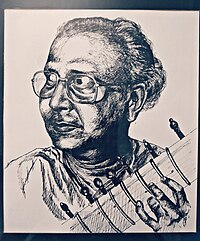Nikhil Banerjee | |
|---|---|
 | |
| Background information | |
| Born | 14 October 1931 Calcutta, Bengal Presidency, British India |
| Origin | Calcutta, India |
| Died | 27 January 1986 (aged 54) Calcutta, West Bengal, India |
| Genres | Hindustani classical music |
| Occupations | Composer, sitarist |
| Instruments | Sitar |
Pandit Nikhil Ranjan Banerjee (14 October 1931 – 27 January 1986) was an Indian classical sitarist of the Maihar Gharana. Along with Pandit Ravi Shankar and Ustad Vilayat Khan, he emerged as one of the leading exponents of the sitar. He was a recipient of the Indian civilian honour of the Padma Bhushan.[1]
In 1947, Banerjee met Allauddin Khan, who was to become his main guru along with his son, Ali Akbar Khan. Both were sarod players. Banerjee went to Allauddin Khan's concerts and was desperate to have him as his teacher. Allauddin Khan did not want to take on more students, but changed his mind after listening to one of Banerjee's radio broadcasts. Allauddin Khan was Banerjee's main teacher and after he left Maihar he also learnt from Ali Akbar Khan, the son of Allaudin Khan, for many years.[2]
Ustad Allauddin Khan was passing on not only playing technique but the musical knowledge and approach of the Maihar gharana (school); yet there was a definite trend in his teaching to infuse the sitar and sarod with the been-baj aesthetic of the Rudra veena, surbahar and sursringar—long, elaborate alaap (unaccompanied improvisation) built on intricate meend work (bending of the note).[citation needed] He was also well known for adjusting his teaching to his particular students' strengths and weaknesses. Consequently, under his teaching, Shankar and Banerjee developed different sitar styles.[2]
In an interview Nikhil said he had been influenced by Allauddin Khan, Ali Akbar Khan, Amir Khan, and to a lesser extent by Omkarnath Thakur, Faiyaz Khan, Kesarbai Kerkar, and Roshanara Begum.[citation needed]
For Banerjee, music-making was a spiritual rather than a worldly path:
Nikhil Banerjee is revered for his mastery in both melodic and rhythmic aspects of Indian music. His unique style of sitar playing is considered to have completeness, emotion and depth. His interpretation of ragas was usually traditional, although he is credited with creating at least two new ragas. His usage of a completely "bandh" or "closed" jawari in the Maihar style sitar allowed for a much greater amount of sustain (since the strings are not buzzing against the bridge as much) as can be heard in his unique sound. Though his strings do not sound as "closed" as Ustad Vilayat Khan's sitar playing, it was only due to the technical differences in their physical sitars (and jawari was changed specifically for the Jor strings etc.) that the sitars sounded in "different" style.
According to the San Francisco Chronicle, Banerjee's "technique is a phenomenon, faster than cheetahs, more secure than the dollar." Music and Musicians observed that "his improvisations always sound completely natural and spontaneous." In an obituary the New York Times wrote "the extraordinary fluidity and assurance of his rhythmic ideas and phrasing set a standard that would have left the more international 'stars' of Indian music behind."[4]
The following is a summary of some recent CD issues. A more comprehensive discography can be found in the external links.